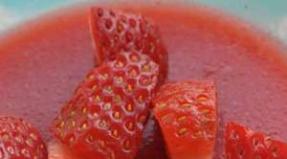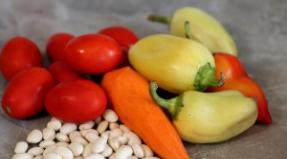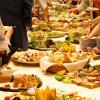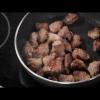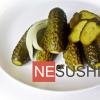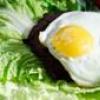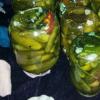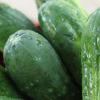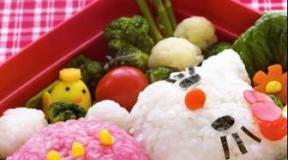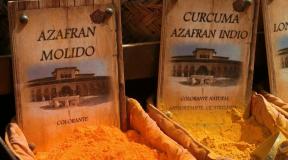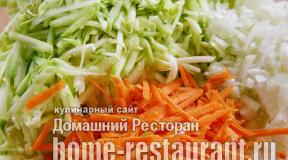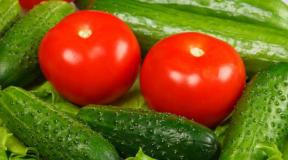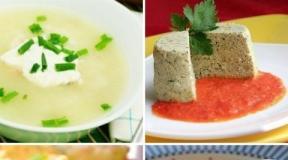Composition and requirements for various types of test. Types of dough and its use
There are two types of dough: yeast and yeast-free.
Yeast-free dough
Unleavened dough is prepared in different ways. Soda or ready-made chemical baking powder is used as a disintegrant. With the help of them they prepare shortbread, gingerbread, waffle, unleavened pastry, etc. Also, yeast-free dough is prepared by means of intensive beating. These types include: biscuit, almond, for pancakes, meringue.
A separate type of dough is puff pastry, which is prepared by the principle of sandwiching fat-containing products. And the last way to make yeast-free dough is to make flour. In other words, choux pastry.
Yeast dough
Yeast dough is divided into two types, cooked sponge and straight way. In the preparation of the sponge method to start making a brew. It is a batter made from flour, water and yeast. After a long standing, the remaining ingredients are added to the dough. Straight dough is cooked much faster. To do this, just knead the dough and allow it to separate. Cookies, big cakes, buns, etc. are made from sponge dough.
A variety of pastries, pancakes, pizza, and donuts are prepared from the dough prepared using the straight-through method.
Shortbread dough
The main ingredients of such dough are sugar, butter and flour. You can also add sour cream, eggs, nuts, raisins, vanilla sugar, cocoa, lemon zest, etc. Prepare such a dough quickly. After that, you need to remove it in the fridge, wrapped in plastic wrap. The test should lie down for about 30 minutes.
From it prepare the open and closed pies, cakes, cookies, tartlets.
Biscuit
The main ingredients for sponge dough are eggs, flour and sugar. You can also add cocoa, fruit, nuts, etc.
Cakes, pastries, rolls are usually made from biscuit dough.
Puff pastry
The classic recipe for puff pastry is made from butter and flour. The oil will be fatter, the more magnificent and more crisp pastries work. Puff pastry is divided into yeast and yeast-free. Puff pastry goes well with sweet and savory fillings.
Samsu, croissants, strudel, khachapuri, puff pastries and Napoleon cake are made from it. And also prepare various pies with fruit, berries, cottage cheese, meat, cheese, etc.
Sweet dough
The basis of this test is sour cream or kefir, flour, butter, sugar. Eggs and baking powder may also be added.
It is good pastry dough for pies and pies.
Choux pastry
Prepared by brewing flour. After added eggs, oil, salt. Inside, the pastry is hollow with a hard crust on top.
Shu cakes, eclairs, profiteroles are made from it, and various sweet and savory pastries are prepared. And also delicious desserts.
- If you are preparing yeast dough, then one of the main rules is the absence of drafts and the room should be warm enough.
- All ingredients must be of the same temperature in order for the yeast dough to rise well.
- The temperature of the liquid in the preparation of the dough must be about 35 degrees in order for the yeast to start working. If the temperature is higher, then the yeast will lose its properties. When low - will not be active.
- Yeast dough give a good distance, as well as after the formation of products. If the dough is not enough distance, then baking will not rise well and probably will not bake.
- Margarine or other fat must be melted in advance so that it is slightly cooled.
- Sweet pies are better to cook with milk, so they will be more delicious.
- If the cake is large and high, then it should be baked on a lower fire.
- All fats are added at the end of kneading.
- If more yolks are present in the dough, it will be more crumbly, with a pleasant yellow color.
- To make the cakes more rosy and appetizing, it is better to lubricate them with yolks mixed with milk and also with sweet milk on top.
- It happens that the dough is sticky, then cover it with baking paper, so it will be easier to roll it.
- If according to the recipe it is necessary to put raisins or dried fruits in dough, then sprinkle them with flour.
- With an increase in the amount of fat in the dough, pastries will not become stale for a long time and will be more crumbly.
- Yeast must always be used fresh. If you use extruded, they will not be very dark with a slight alcohol odor.
- Good baking also depends on the quality of the flour. Good flour will not be wet, from white to cream.
- The dough will be well suited if you cover it with cling film and then put it in a room where there are no drafts. It is very good to use a slightly heated oven for this or simply put it in the cupboard.
- The dough after proofing increases in volume by about 2 times.
- If you need to prepare the straight dough in advance, then put it in the fridge, where it will last longer.
- Cocoa, cinnamon and other spices are best mixed with sugar or flour. So they are better distributed in the test.
- Formed cake is usually melted for 30-40 minutes. Small products stand for 15-20 minutes. Be sure to cover them well, so as not to form a crust.
- If you are preparing a cake or buns with berries, add a little starch. Thus, the juice does not soak the dough and will remain inside the baking dish.
- Baking should be greased with an egg after proofing, just before sending it to the oven.
- If you smear unsweetened pastries with vegetable oil, then it will be softer, ruddy and fragrant.
- Before baking, the oven should be well heated. Never put in a cold oven.
- To the bottom of the cake is not burnt, put in the bottom of the oven dishes with water.
- Ready baking should be elastic when pressed.
- If you want to bake after cooking was soft, then grease it with melted butter or vegetable and cover. If you prefer a crisp crust, then cover and lubricate is not necessary.
- If there is excess liquid in the dough, then the baking is flattened and blurry.
- If you get a very steep dough, then it is badly roaming, baking turns out dense and does not rise during baking.
- When replacing water with milk, cream or kefir, you get aromatic, lush and beautiful pastries.
- With a very large amount of sugar, the products quickly turn brown, and the middle is poorly baked.
- If the number of eggs increases, the cakes will be more tasty and crumbly.
- Never put the yeast in the dough, otherwise the pies will have an unpleasant smell.
Baking is food products, in the technology of which different ingredients are used with additional ingredients. It is large: rolls and loaves. There is also a smaller one: cookies, muffins, pies and pastries.
Distinctive features of products
As a rule, all have a high calorie content. These products are quickly and easily absorbed by the body. Baked delicacies - it is always something tasty and fragrant, causing increased appetite. The most important element in the preparation of any baking is flour. No flour - no baking. Already different fats are added to a certain type and type of flour (vegetable oil, butter, margarine). Also a frequent ingredient in the manufacture of pastries are eggs and yeast. Sugar is present in many Additional products may be sweet ingredients: honey, chocolate, fruit, jam, condensed milk and sour cream. There can be unsweetened complementary baking products: meat, cottage cheese, mushrooms and various vegetables, fish.
What are baked products
Types of dough and baking from it have an extensive range. Products are divided into several groups. Belonging to the relevant group indicates from which ingredients the products are prepared.
Yeast Products
The most popular is baking using yeast. Any product that has at least a little yeast automatically becomes a yeast product. No matter what ingredients were added during the dough kneading process. Yeast can be familiar to all the usual bread. and cheesecakes with cottage cheese also fall into this category. Even pancakes made from pancake dough will become yeast when you add this item to the dough. As you can see, the types of yeast baking occupy the largest segment of baked products.
Other popular dough types
- The dough can be sandy. Sand dough is prepared on the basis of fats (butter, margarine) with the addition of special baking powder and powdered sugar.
- Curd dough cakes have a very small amount of flour in their composition, but curd or mascarpone is the main ingredient. Curd dough, like its products, can be sweet or salty.
- All types of baking (photos provided in the article below) of puff pastry look appetizing and the taste is appropriate. They can also be sweet: with jam, jam, powdered sugar. And can be savory. These are products from puff pastry, which can be stuffed in the form of mushrooms, fish and bacon with cheese.

- Dough for making pastries and cakes, most often biscuit or butter. Very sweet and high in calories. And always delicious.
- Pancake dough - for different types of pancakes and pancakes. It also has a variety of flavors - from sweet to more salty. And the fillings for pancakes, respectively, are selected to taste the dough. The pancakes themselves are considered the original Slavic ritual dish. The love of pancakes in our people lives on a genetic level. In addition, it is quite economical and versatile baking.
Despite the fact that there are many different and tasty products based on flour, each dough product has its admirers. At the end of the article we offer you a couple of simple cooking options for different types of baking. You can cook them without much time and cost.
Biscuit for tea

Biscuit - the favorite treat of the British. A simple dry biscuit is traditionally included in the British file-o-shred. You must take the following products:
- four fresh eggs;
- one hundred and twenty grams of sugar;
- one hundred and twenty grams of flour (top grade).
Bake the product:
- The first thing you need to heat the oven to two hundred degrees.
- We take two bowls and divide the eggs into proteins and yolks.
- Beat yolks with 2/3 of the whole norm of sugar. Beat until you get a fluffy, light mass without sugar inclusions. Homogeneous egg mixture should "drag" behind the whisk.
- Now whip proteins into a very stable foam. Such a foam when turning the bowl should remain as it is - in the bowl. Only after such a check can the rest of the sugar be poured into the protein foam. Continue whipping until the meringue is white, firm and shiny.
- Sift flour and pour into the yolk mass. Affectionately, without sudden movements, we mix the future biscuit.
- After the flour, whipped proteins are introduced into the biscuit dough and are also gently mixed with the dough.
- Smear the form with butter and lightly sprinkle with flour.
- We send the dough in the form and put in a hot oven.
- When baking a biscuit, never open the oven. The heated air will quickly leave the oven, and the cake will be flat and not very beautiful.
- When twenty minutes have passed, a wooden skewer pierce the product in the middle. If the skewer remains dry, sponge cake is baked. Let it stand for ten minutes in the oven off.
- After a specified time, you can remove the biscuit and cool it on the grid.
This type of baking is good for tea, coffee, cocoa and milk. Everywhere it will be appropriate. If you cut the biscuit across and smear the cut with any jam or cream, and then cover the whole product with cream, you will get a wonderful light biscuit cake.
Curd dough and cupcakes from it

Bake tender muffins from cottage cheese dough. Products required for cupcakes:
- one hundred grams of cottage cheese;
- one hundred grams of flour;
- fifty grams of butter or margarine;
- one egg;
- eighty grams of sugar;
- teaspoon baking powder.
If this amount of ingredients did not seem enough to you, multiply them by two.
Cooking technology cupcakes:

- Cottage cheese mix with egg.
- Pour sugar to the resulting mass. Add the melted butter.
- Mix all these ingredients with a whisk or fork. We interfere, trying to grind the curd into smaller particles.
- Mix the flour with baking powder and enter into the curd-egg emulsion. The resulting curd dough has a creamy texture.
- The dough is immediately laid out in small molds for muffins. Lubricates before this molds with vegetable oil. Each need to fill only 2/3. This is explained by the fact that the products during baking will increase in volume. Put the forms in the oven and turn it on.
- Cupcakes are baked at a temperature of one hundred and seventy to two hundred degrees to readiness. Product readiness is determined by inspecting the crust. As soon as the cupcakes become light brown in color, the items can be removed.
Of course, all types of baking in one article does not cover. A lot of them. And in every part of the planet they bake something of their own according to unique recipes. Cook with pleasure, but remember that such a passion can affect your figure.
All of us, one way or another, have to deal with tests in our life. But there is a small nuance: for many people, tests are just tasks that differ in subject, direction and form. However, in reality, the topic of tests is a whole science, and you need to know what tests are and what they are intended for.
You see, if you use an inappropriate test in a specific situation, you can get not only unreliable results, but also have a negative impact on your future life as a result, which can be expressed, for example, in ineffective training and even incorrect. To avoid this, we offer you to get acquainted with interesting and useful information about the tests, which will be useful both for students (both those who are engaged in independent learning) and teachers.
Test classification: basic approaches
Today there are two main approaches to the classification of tests:
- The first approach focuses on the criterion - this includes criteria-based tests.
- The second approach is focused on the norm - this includes normative-oriented tests.
Initially, these approaches appeared as different ways of analyzing test results and reflected various grounds for comparison. But now they are defining the difference at almost all stages of test creation.
In criterion-oriented tests, the results are interpreted according to: tasks are offered, answers are given and conclusions are made as to whether the subject meets the specified specific criteria.
In normative-oriented tests, the findings are supplemented by a rating: tasks are offered, answers are given, conclusions are made about what knowledge the subject has, and what place he occupies on a given scale.
Below we provide a table with the main characteristics of each type of testing.
| Indicator | Criterion-oriented test | Regulatory oriented test |
| Application area | Material proficiency testing | Survey Testing |
| Value | Identify the tasks that the subject is able to perform | Identify individual differences in terms of acquired knowledge |
| Processing results | Individual results are compared to a specific area of achievement. | Individual results are compared with the results of other subjects. |
| Scope | Fixed a limited set of tasks | Covers a broad scope |
| Test Plan Property | The peculiarities of specific criteria are taken into account. | The criteria table is applied. |
| Selection of questions | The questions required for adequate analysis are compiled. No attempt is made to remove light questions or change the complexity of questions. | Matched issues that can provide the maximum variety of assessments. Light questions are usually not included in the tests. |
| Performance standards | The execution process is driven by absolute standards. The degree of ownership of the material is demonstrated through the definition of 90% of specific terms. | The execution process is determined by the specific position in the group. |
In the process of building a testing system, methods and scope of the entire test tool are usually established. Both the method and the variant of creating tests depends on how widely you plan to use this test material.
Test classification: complementary approaches
In addition to the already considered approaches to the classification of tests, there are others. They are based on different characteristics.
The creation procedure classification - tests can be standardized and not standardized.
Classification by means of presentation - tests can be:
- Blank (used paper and pen / pencil)
- Subject (objects are manipulated, and the results depend on the accuracy and speed of the tasks)
- Hardware (special devices are used for the study of personal characteristics, for example, perception, etc.)
- Practical (test equipment is applied, instructions are offered)
It should be pointed out here that any type of testing is suitable for educational purposes, but separate attention should be paid to the fact that different results can be obtained by presenting the same test in different forms, and such results cannot be compared with each other.
Classification by orientation - tests can be directed to various objects of study:
- Achievement Tests
- Tests to determine personal characteristics
Classification by the nature of the action - tests can be:
- Verbal (it is necessary to perform mental actions, for example, to take part in word-logic games or work with knowledge questionnaires, etc.)
- Non-verbal or practical (it is necessary to manipulate specific objects, for example, parts, blocks, cards, etc.)
Leading activity classification - tests can be:
- Speed tests (all tasks can not be completed within the set time, because it is strictly limited)
- Tests of power (time to perform tasks is not limited, but there are tasks of increased complexity)
- Mixed tests (included elements of speed tests and power tests)
The presented group of tests is most often encountered in practice, since tests offered in educational institutions and organizations relate to it.
Classification by purpose (applies only to the educational system) - tests can be:
- Tests of knowledge and behavior of students in the initial period of study (defining tests)
- Tests of learning difficulties and their sources (diagnostic tests)
- Tests for major achievements at the final stage of training (summation tests)
And to summarize the classification of tests can be another of their kind, which appeared relatively recently - this is because tests that imply passing on the Internet and, as a rule, give results within a few seconds. Such tests can have completely different directions, from diagnosing IQ and creative abilities to determining personal characteristics (character, temperament, etc.) and career choices. It is worth noting that recently online tests have gained enormous popularity among people all over the world, and the percentage of their use is many times more than any other tests.
Application of tests in practice
Each person should understand that truly effective tests are developed and should be developed only by specialists - people with professional knowledge and experience. At the same time, a lot of tests that can be found today not only on the Internet, but also in print media (we’re not talking about educational institutions and organizations here, as they comply with the above mentioned requirement) are extremely unprofessional. Such tests themselves, and especially their results, cannot be taken seriously. Distinguishing a standing test can be very simple: it is either provided with a brief overview, which provides data justifying its relevance, or at least a link to its author, who is an expert in a particular field (for example, you can look or).
But, even using only high-quality and competent tests, it is impossible to expect that the assessment of a person’s personality and abilities will be 100% reliable. The only way to evaluate a person by any parameters has always been and is direct communication with him, and communication should take place over a long time, in different living conditions and situations. It follows that testing is only one of the tools that can be used for diagnostics.
Passing tests or using them in your activities, count only on what they can show, even if they are close to reality, but only an approximate picture of what you want to know. Although, of course, tests always help save time and choose a specific strategy for action, behavior, interaction or work.
Considering all this, in your life and work you need, firstly, to use only the most professional tests, and, secondly, you should treat them only as signs to your further development. If you are a big fan of all sorts of tests, and you like to take even the simplest and unreliable, take them as an exciting way to relax and spend time.
Depending on the main type of raw material, the dough can be divided into two groups: with flour and without flour.
Flour dough used for the preparation of flour dishes, culinary and confectionery.
Dough without flour (for example, proteinaceous air) - mainly for the preparation of confectionery (Fig. IV.2).
Depending on the method of loosening, the flour dough is divided into yeast (sour) and fresh (yeast-free).
Yeast (sour)
Fresh (unleavened)
Yeast Puff
No flour
For pancakes
Simple
Sugar and protein
For pancakes
noodles
For pancakes
shortbread
Waffle
Fresh butter
Biscuit
Choux
Almond nut
Fig. Classification test
Yeast-free dough according to the method of loosening, in its turn -\u003e the unit is divided into several types:
* cooked with chemical baking powder (sand, butter, wafer, gingerbread, etc.);
cooked by beating (biscuit, air, almond);
layered (puff);
cooked in a brewed way, in which the whole flour or part of it is brewed (brewed).
Yeast dough consistency can be jewkim(for pancakes and fritters) and thick(for pies, pies, etc.)
Yeast-free dough can also be of different consistency: liquid (for pancakes, waffles), semi-liquid (biscuit), thick (noodles, shortbread, fresh sweet, puff, brew).
In cooking, the dough is used for cooking:
* cooked flour dishes (noodles, ravioli, dumplings, dumplings) and fried (pancakes, fritters, pancakes);
* flour culinary products (pies, pies, kulebyak, pies);
* semi-finished products for serving dishes (tartlets, volovanov, fluron-croutons from puff pastry for serving cutlets from chicken fillet, etc.).
The processes occurring during the dough kneading and baking products from it
As a result of kneading get a homogeneous mass of flour, water and other components with special physical properties: elasticity, extensibility, elasticity. The mechanism of dough formation can be represented as follows. When water is added to flour, its colloids, protein substances and starch contained in flour in the form of dry gels, swell. In the process of protein swelling, approximately 1/4 of all absorbed water is adsorbed by binding, the rest is osmotically. Protein swelling after dough kneading occurs within 20-30 minutes. This forms a colloidal aggregate - gluten, which is important for the formation of the physical properties of the dough. Swollen protein substances form the skeleton of the spongy structure, which gives the test stretchability and elasticity.
Fiber, the amount of which depends on the type of flour, also absorbs a significant amount of water.
The amount of water added to the standard moisture flour during dough production ranges from 35 to 165% by weight of the flour. The humidity of various types of dough and finished products from them is standardized by technological documents.
Simultaneously with the colloidal processes in the dough, enzymatic processes take place, as a result of which part of proteins are hydrolyzed (protease and peptase enzymes), part of fats (lipase enzymes). The amylolytic enzymes of the flour convert part of the starch into dextrins (the enzyme amylase) and maltose, and then the maltose into glucose (the enzyme maltase).
When knead yeast dough and its subsequent fermentation, yeast enzymes (sucrase and maltase) ferment sucrose and maltose to monosaccharides, which then participate in alcohol and lactic acid fermentation.
With a characteristic external sign of changes in products from yeast dough or from dough with chemical, mechanical disintegrating agents, a rapid increase in their volume, usually lasting no more than 5-6 minutes and ending as a result of crust formation and a change in the consistency of the dough inside the product, is. The volume of the baked product is 10-30% more than the volume of dough pieces after proofing and depends on the amount of gaseous substances formed as a result of the decomposition of chemical leavening agents or fermentation products in yeast dough. Soda and ammonium begin to decompose with the release of carbon dioxide at 60-80 ° C.
The temperature of the surface layer of products quickly rises and at 100 "C from it moisture begins to evaporate rapidly. Moisture is transferred from areas (from the outer layer), where the temperature is higher, to the inner crumb layers, where the temperature is lower (heat transfer phenomenon). As a result, the top layer gradually turns into an almost completely dehydrated crust with a temperature of 130-150 ° C. Its color and flavor are due to processes such as melanoid formation, dextrinization of starch, aramelizatsiya sugars.
In the inner layers of the product, the temperature is close to 100 ° C. When heated over 70 ° C, gluten proteins denature and coagulate. At the same time, the moisture absorbed by the proteins during the kneading of the dough is released and the gelatinising starch absorbs it, i.e. the moisture is redistributed. The denaturation of proteins and the gelatisation of starch are the main processes responsible for the transition of the dough into crumb, the formation of a solid structure of products.
Baked products as a result of water loss during evaporation have a smaller mass than products before baking. The ratio of the difference between the mass of the product before and after baking to the mass of the product before baking is called package. Express it in percent and calculated by the formula:
U = m 0 - m k / m 0 100%,
where m 0 - the mass of the product before baking;
m k - the mass of the product after baking.
The baking of one or another dough is the higher, the more moisture it loses when baking, that is, the smaller and thinner the baked product and the longer the heat treatment; the higher the humidity of the dough, the higher the pack.
Weight loss during the cooling of products is called shrinkage.
The mass of the finished product is always greater than the mass of flour used to make the product. The ratio of the mass difference between the baked product and the flour taken during its kneading to the flour mass is called pripek (P). It is calculated by the formula:
P = m t - m m / m m 100%,
where m 0 - the mass of the baked dough;
m t is the mass of flour taken for the dough.
The pripek of a dough is higher, the more water is introduced into the dough. Flour with high-quality gluten, when kneading dough, absorbs more moisture than flour with weak gluten, it also increases the amount of the product.
Soft, airy, fragrant pastry few people can leave indifferent. That's just not everyone can cook it at home. And absolutely nothing! After all, knowing a few basic secrets and subtleties, you can turn the process of making buns, cakes and pies into an exciting experience.
There are at least 7 types of dough, which you should definitely try to cook yourself. We talk about the secrets and subtleties of delicious and delicious baking and share basic recipes - homemade will be satisfied!
Pizza dough
Try to cook a delicious and flavorful pizza on a thin crispy crust - you will be surprised how easy it is. But first, remember a few basic rules:
- Be sure to sift the flour - it will saturate it with oxygen and make the dough soft and airy.
- For the test, use only high-quality yeast, otherwise the dough does not rise well and will have an unpleasant beer smell.
- Yeast dough does not tolerate drafts, so carefully close all doors and windows.
- Use cold, but not ice-cold water for cooking - so the dough will be soft and elastic.
- Pizza dough need not roll out, and gently stretch your hands from the middle to the edges.
- Make the edges of the cake a little thicker for the sides.
- To prevent the dough from sticking to the form, brush it with vegetable oil and lightly sprinkle with flour.
Ingredients:
- Water 2/3 cup
- Dry yeast 1 tsp.
- Wheat flour 2 glasses
- Salt 1 tsp.
- Olive oil 1 tbsp. l
Cooking method:
- Fill the yeast with warm water and stir well to avoid lumps.
- Add flour, salt and diluted yeast to the bowl. Knead the dough.
- Put the dough on a dry, floured surface, and knead, adding flour as necessary, for about 10 minutes until the dough should be soft and elastic.
- Brush the dough all over with olive oil and place in a clean, large bowl.
- Cover with cling film and place in a warm, without drafts, place for 1.5 hours - the dough should increase about 2 times.
- Mash the dough with fists, divide it into 2 equal parts and form balls.
- Put balls of dough on a floured surface, cover with cling film and leave for 60 minutes.
- Hands, stretch the dough to a layer of the desired thickness. Put the stuffing and send in the oven heated to 180-200 degrees for about 10 minutes.
Puff pastry
Puff pastry is universal. It serves as an excellent base for cakes and pies, as well as for cakes and pies with unsweetened meat or vegetable filling. Cooking this dough is easy, but there are a few subtleties that must be taken into account:
- Salt, vinegar and citric acid affect the quality, elasticity and taste of the dough. Therefore, strictly adhere to the amount specified in the recipe.
- Milk improves the taste of the dough, but decreases its elasticity. Therefore, dilute the milk with water in a 1: 1 ratio.
- Butter for the dough should be chilled, not frozen - hard pieces will tear the dough, and not interfere with it.
- The more times you roll out the dough, the more it will turn into layers.
- Roll out the dough with a uniform pressure in the direction away from you. Do not go beyond the edges of the dough so as not to damage the structure of the layers.
- Before sending the dough into the oven, make cuts on its surface that will help you get out of steam.
- Bake puff pastry products at a temperature not lower than 220 degrees. At lower temperatures, the layers will not rise, and at high temperatures, baking will burn.
Ingredients:
- Flour 300 g
- Butter 150 g
- Milk (diluted with water)2-3 Art. l
- Vinegar 1 tsp.
- Egg 1 pc.
- Salt 1 pinch
Cooking method:
- Pour 150 grams of flour on a dry, clean surface. In the center, make a recess, break the egg there, add vinegar, milk and salt.
- Stir the ingredients thoroughly and knead the dough until bubbles form.
- Slice the butter into small pieces and add the remaining flour. Mix everything and knead the dough. Long knead the dough is not necessary.
- Roll out the first dough in a thin layer, put the dough with butter in its middle and wrap it in an envelope.
- Roll out the dough in the direction away from you, sprinkle it with flour, fold in three and put in the refrigerator for 30 minutes.
- Roll out the dough 4 more times, after each rolling, folding the dough three times and sending to cool for 10 minutes.
- Divide the dough into pieces, fill with filling.
- Bake in the oven preheated to 220 degrees.
Shortbread dough
Sand dough is a real find for lovers of sweet pastries. Crumbly cookies, baskets with cream or fruit pies - you can make homemade new desserts every weekend if you use our tips:
- Butter for cooking dough should be chilled, but not frozen.
- Use cold but not ice-cold water for cooking.
- Do not regret the oil for the dough - it depends on its friability.
- The oil should not be mixed with flour, but grind it with it to the state of crumbs.
- Do not knead the dough for too long, otherwise the butter will melt and the dough will not be crumbly.
- To make the dough more tasty and crumbly, replace the sugar in its composition with powdered sugar.
Ingredients:
- Wheat flour 2 glasses
- Sugar 1/2 cup
- Butter 150 g
- Salt 1 pinch
- Vanillin to taste
Cooking method:
- Mix sugar, salt, vanilla and flour.
- Cut the cooled butter into cubes and add to the mixture.
- Grind everything to the consistency of bread crumbs.
- Gradually add the liquid and knead the dough quickly but smoothly. The kitchen should be cool so that the oil does not have time to melt.
- Form a ball from the dough.
- Wrap in cling film and refrigerate for 30 minutes.
- Roll out the cake, cut into the desired molds and place on a baking sheet.
- Bake at a temperature of 180-200 degrees.
Dough for ravioli
Dumplings are a traditional Russian dish, and being able to cook them is a matter of honor for every hostess. If you do not yet have the trademark secrets of making dumplings dough, use our basic recipe. And at the same time remember a few rules:
- Flour for dough must be sifted.
- Knead the dough on a circle in one direction.
- After kneading, the dough should be allowed to "rest" under a clean towel for 30 minutes.
- The thickness of the dough should be no more than 1-2 millimeters.
Ingredients:
- Wheat flour 500 g
- Egg 2 pcs.
- Water 200 ml
- Salt 0.5 tsp.
- Vegetable oil1 tbsp. l
Cooking method:
- Sift the flour through a sieve.
- In the resulting slide, make a depression and pour a mixture of water, eggs and salt into it in a thin stream.
- Gradually knead the dough in a circle, one way. At the same time constantly take the flour from the edges to the middle. The longer you knead the dough, the more elastic it will be.
- Send the finished dough to rest for at least 30 minutes.
- Roll out thin dough out of dough, cut out blanks with a glass, fill them with stuffing and make dumplings.
- Boil in boiling salted water for 10-15 minutes.
Biscuit dough
- All the ingredients for the biscuit and dishes, in which they will be mixed, should be the same, cool temperature.
- To saturate the flour with oxygen, it is necessary to sift it several times.
- Carefully separate the whites from the yolks - this affects the quality of the protein mass. Whites should be cooled when whipped.
- Ingredients must be mixed briefly, otherwise you will destroy the air bubbles with which the biscuit is saturated mixture.
- The oven must be preheated to a temperature of 180 degrees. If the dough has to wait until the oven warms up, the cake will not be fluffy.
- The first 20-25 minutes of baking the oven door cannot be opened, otherwise the biscuit will settle.
Ingredients:
- Wheat flour 180
- Sugar 150g
- Eggs 4 pcs.
- Vanilla to taste
Cooking method:
- Separate the whites from the yolks.
- Beat the whites on the smallest mixer speed, gradually adding 1 tsp of sugar and vanilla.
- Then, without stopping the beating, add 1 beaten spoon of pre-beaten yolks.
- Sift flour several times.
- Add flour to a bowl of squirrels, gently stirring with a spoon from bottom to top.
- Pour the finished dough into the form with high sides, pre-covered with baking paper.
- Send the sponge cake to the oven preheated to 190–200 degrees for 20–25 minutes.
Choux pastry
Another kind of dough, preparation of which is to master perfectly. Choux pastry makes a lot of delicious pastries - profiteroles, eclairs and even cakes. Before you begin the cooking process, remember these simple rules:
- Be sure to sift flourotherwise the dough will turn out with lumps.
- Flour should be poured into the pan in a neat trickle - for this, use a sheet of paper folded in half.
- Add the eggs to the already cooked dough, cooled to room temperature.
- Eggs must be at room temperature..
- Do not use a mixer for mixing, otherwise the dough will turn out too thin.
- Turn on the oven at the same time as you start cooking the dough. By the time the products are placed in the oven, it should be heated to 200 degrees.
- To prevent finished products from dampening, cover them with paper napkins - they absorb moisture.

